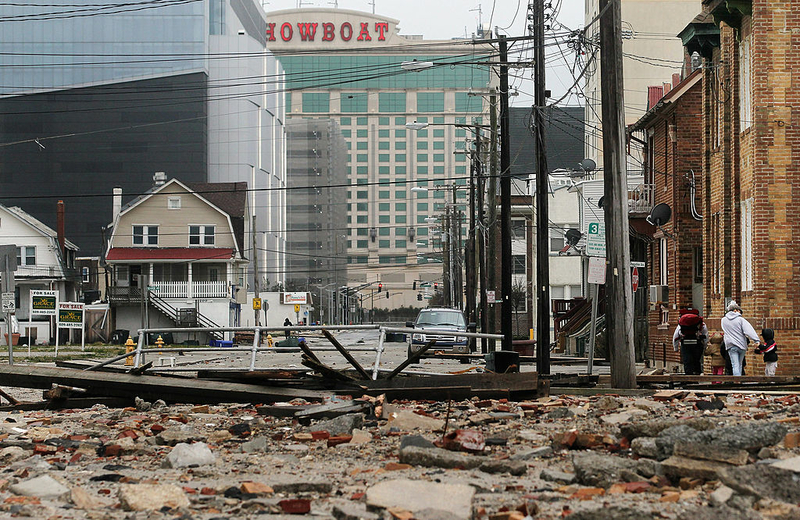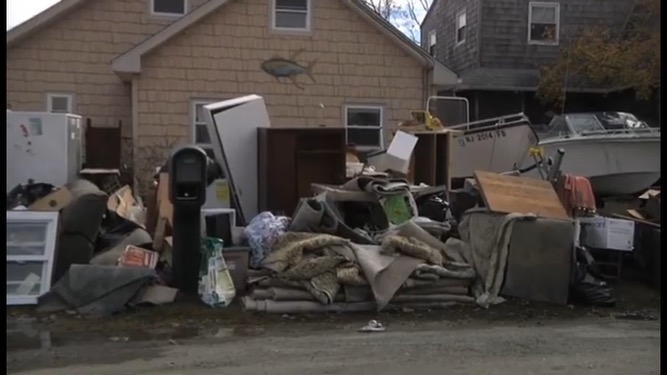A decade after Hurricane Sandy, fight to reform disaster relief continues

After Hurricane Sandy flooded Robert Lukasiewicz’s home a block from the bay in Atlantic City, the problems piled up.
Contractors pocketed his money but never finished their work. He couldn’t afford flood insurance, making him ineligible for some relief funds. Caring for terminally ill relatives kept him from rebuilding for several years. Then the pandemic created labor and material shortages that sent construction costs skyrocketing.
The government now is demanding he return $96,000 he received in relief funds to rebuild his century-old home that today, a decade since Sandy, remains a gutted, uninhabitable shell. That’s money Lukasiewicz — who spends summers selling ice cream on the beach but now is unemployed — doesn’t have.
“After the storm was harder than going through the storm,” he said.
Lukasiewicz’s struggle is far from unusual for the 346,000 New Jerseyans whose homes were damaged or destroyed in the deadliest, most catastrophic storm to ever hit the Garden State. It hit the region 10 years ago this Saturday.
Many remain in limbo after the government said they received too much money for rebuilding and must repay it. Advocates say such clawbacks are just the latest insult to Sandy survivors, who waited over a year to receive relief funds, found fraudulent contractors faced little accountability, and had to navigate a maze of government programs where one misstep could delay recovery for years.
“The system is broken,” said Jody Stewart, a Sandy survivor from Little Egg Harbor Township’s Mystic Island. “Every storm is like Groundhog Day. We have the same fights over and over.”

Policymakers insist the state has made plenty of progress toward storm resiliency since Sandy.
Officials have spent more than $200 million to buy back 350-plus acres of flood-prone properties, demolish about 740 structures there, and preserve the acreage as parks or restored natural habitat.
Officials also invested billions in beach replenishment. And they have passed green laws electrifying buses, advanced efforts to generate power through offshore wind, and otherwise set goals to reduce greenhouse gas emissions, which worsen climate change and create the extreme weather that has caused catastrophic flooding and rising sea levels.
But much remains to be done, especially when it comes to helping storm survivors recover, advocates say.
Stewart, 64, is a high school graduate who spent her life working in the bait and tackle industry in Ocean County.
After Sandy, she became an activist. She now works to change state and federal laws to help storm survivors as senior organizer with the New Jersey Organizing Project. She estimates there are about 150 families displaced by Sandy who still haven’t gotten back into their homes yet, as well as an unknown number of storm survivors like Lukasiewicz who fell off the relief safety net.
“We need to treat survivors as people, and we need to make sure they get home,” Stewart said. “I don’t care how the state comes up with money, but we should not have survivors who never get home.”
Fixes they’re fighting for
Delays in disaster relief start in Congress, which treats every storm as an unpredictable event and requires new Congressional action to release relief funds.
That’s why Sandy survivors had to wait a year for relief, while survivors of Hurricane Ida — the September 2021 storm that was the state’s second deadliest and costliest — still haven’t gotten money to rebuild.
A bill before Congress now, called the Reforming Disaster Recovery Act, would make a federal aid program permanent, with the goal of getting money to survivors quicker.
Stewart’s group has advocated for its passage, as well as a bill in New Jersey to protect storm survivors and others from predatory or inept contractors. The state legislation would strengthen oversight of home improvement and elevation contractors by requiring them to be licensed, complete ongoing training, and get insurance to make customers whole if a contractor disappears.
For some families that have rebuilt, though, the headaches haven’t ended.
The federal government is trying to recoup $73 million in relief funds they say were erroneously paid to 1,813 households in New Jersey. Officials attribute the overpayments to some families receiving duplicated relief funds and others failing to produce receipts showing work done or comply with other rules regulating relief payouts, Stewart said.

But Lukasiewicz said everything was “chaos” in the weeks and months after Sandy, as survivors scrambled to recover and return home. That meant he didn’t collect the kind of documentation he’d need to stand up to scrutiny a decade later.
“Nobody gives you a manual on how to do this,” he said. “If you’ve never done it before, you just got to figure some things out.”
Duplication of support wasn’t anything survivors considered then, Stewart added.
“They gave us money. They said: ‘Repair your home.’ They never explained: ‘If you get this money, this can be a problem later because you’re not allowed to double dip,’” she said.
Stewart believes some of the clawbacks could be governmental goofs.
After floodwaters splashed over her kitchen counters and destroyed the bulkhead beside her home, she was luckier than most — her husband was a builder, so they were able to renovate and return home within six weeks.
Still, it wasn’t long before the government demanded she repay $20,000 for having asbestos flooring removed in her attic.
She didn’t have asbestos flooring in her attic.
“I asked them for diagrams to show me what they were talking about. And then that wasn’t even my house. It was someone else’s house,” she said. “So the state finally dropped mine after six months because of an error.”
In March, U.S. Reps. Frank Pallone, Bonnie Watson Coleman, and Andy Kim secured a two-year delay — from 2023 to 2025 — for Sandy repayments. In July, they got a provision added to a federal spending bill now before Congress that would fully forgive $28 million owed by 882 households facing clawback bills.
The federal effort comes as state lawmakers mull similar legislation here to forgive clawbacks for low- and moderate-income Sandy survivors who can’t afford repayment.
Lukasiewicz, 59, is rooting for those bills to pass, because he’s been paying both apartment rent in Somers Point and taxes on his storm-damaged home for a decade now.
“If they want their money back, we’re going to be in the $5-a-month club, because I don’t have $96,000 to give them,” he said.
His home has been in his family for generations. And while it may be years before it’s fully restored, he expects it’ll remain in his family.
“It’s so upside down right now, I can’t even sell it,” he said.








